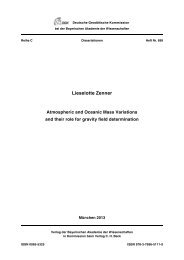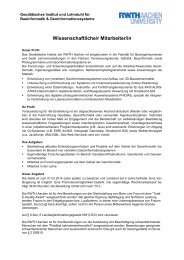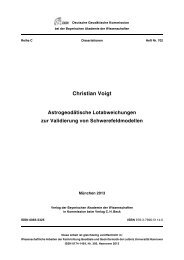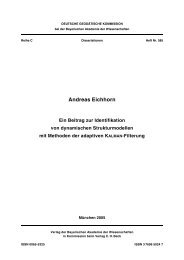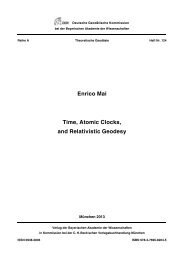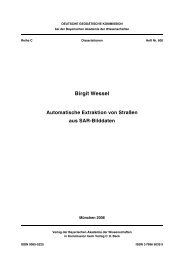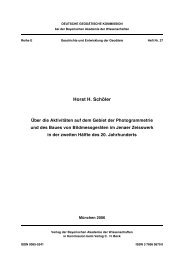v bundesamt für kartographie und geodäsie - DGK - Bayerische ...
v bundesamt für kartographie und geodäsie - DGK - Bayerische ...
v bundesamt für kartographie und geodäsie - DGK - Bayerische ...
Erfolgreiche ePaper selbst erstellen
Machen Sie aus Ihren PDF Publikationen ein blätterbares Flipbook mit unserer einzigartigen Google optimierten e-Paper Software.
274 Fachinstitute an Universitäten <strong>und</strong> Hochschulen<br />
tion, tracking and positioning. It also includes a signal<br />
monitor which analyzes the GNSS signals present in the<br />
IF data stream. At the moment the ipexSR has been<br />
validated for GPS C/A code signals and will be updated in<br />
2004 to track the GPS L2 civil signal and Galileo type<br />
signals.<br />
2.1.4 GNSS RTK Hardware Receiver Development<br />
In cooperation with the IfEN GmbH and the Frauenhofer<br />
Institute for Integrated Circuits a prototype RTK receiver<br />
is being designed and developed. Within the last years<br />
numerous studies have been performed to assess the performance<br />
of a future RTK system using GPS and Galileo<br />
signals. These theoretical studies include signals acquisition,<br />
tracking, multipath mitigation, ambiguity resolution, positioning<br />
and integration of other sensors like INS systems<br />
and integration with internet.<br />
One of the most critical parts in RTK positioning is successful<br />
carrier phase ambiguity resolution. Carrier phase<br />
ambiguity resolution is negatively influenced by atmospheric<br />
–especially ionospheric- delays, thermal noise and<br />
code and carrier multipath. In one study, the effect of<br />
multipath on the ambiguity success rate was calculated using<br />
an end-to-end simulator. The study was carried out in<br />
collaboration with the TU-Delft..<br />
2.1.5 The German Galileo Test Bed – GATE<br />
The satellite navigation system Galileo is currently being<br />
developed in Europe. The main motivation for this development<br />
is to provide a complement to the current GPS and<br />
to ensure independence from GPS. The Galileo program<br />
poses an enormous technological and financial challenge<br />
for Europe. Therefore, associated risks have to be minimized<br />
as far as possible. Test beds are one important<br />
instrument to minimize such risks, as they provide the<br />
necessary infrastructure to validate and optimize the<br />
system’s core elements in advance.<br />
The Institute of Geodesy and Navigation is part of a<br />
consortium of several German companies led by IfEN<br />
GmbH (Prime Contractor). Within the first stage of GATE<br />
(Phase I), the Institute of Geodesy and Navigation provided<br />
extensive scientific consultancy and was involved in the<br />
definition of system requirements. In particular, it was<br />
responsible to analyze to which extent the current GPS can<br />
be used as an efficient reference for GATE. In the following,<br />
the main fields of activity within the framework of<br />
GATE will be presented.<br />
According to its baseline architecture, GATE will consist<br />
of 4 gro<strong>und</strong>-based static pseudolites (pseudo satellites), 4<br />
gro<strong>und</strong>-based but mobile pseudolites, at least one additional<br />
mobile (e.g. airborne) transmitter (in the form of aircrafts,<br />
balloons or airships) and – in the late stage of GATE – of<br />
Galileo (prototype) satellites. Additionally, satellite signals<br />
from the current and future modernized GPS will also be<br />
available. Based on this architecture (which was subject to<br />
slight changes in the meantime), the possibility of determining<br />
the pseudolites’ positions by means of GPS was<br />
analyzed. Thereby, set-up of a differential GPS (DGPS)<br />
network by means of several reference stations as well as<br />
the use of commercial DGPS services like SAPOS have<br />
been taken into account. By means of these approaches, the<br />
pseudolites’ positions are determined by post processing<br />
techniques. Alternatively, the use of real time kinematic<br />
GPS (RTK GPS) has been discussed to provide real time<br />
positioning of the pseudolites. Although very inefficient,<br />
conventional terrestrial methods have been discussed as<br />
well.<br />
In order to make the test bed as flexible as possible, the<br />
signal generators are to be designed to transmit both Galileo<br />
and GPS signals (according to the baseline architecture)<br />
resulting in special design requirements. Related issues<br />
(modification of the pseudolites’ navigation messages,<br />
necessity of pulsing,…) have also been addressed. Furthermore,<br />
the use of GPS to implement a coordinate and time<br />
frame for GATE as well as several approaches to use GPS<br />
for validation purposes (both real time and post processing<br />
validation) have been discussed.<br />
2.1.6 GNSS Software Simulator<br />
In the last few years a couple of GNSS simulation tools<br />
were developed at the Institute of Geodesy and Navigation,<br />
the IfEN GmbH and the Astrium GmbH. Each of the<br />
simulation tools covered different scopes in the field of<br />
satellite navigation. None of these simulators is capable to<br />
cover all areas in satellite navigation or to be extended to<br />
do this.<br />
In Summer 2001 the BaiCES project, financed by the BFS<br />
(<strong>Bayerische</strong> Forschungsstiftung), started, which includes<br />
the development of complete GNSS System simulator.<br />
The so called BaiCES simulator is based on the commercial<br />
simulation environment, ML-Designer, from the Mission<br />
Level Design GmbH. This simulation infrastructure enables<br />
the user to build up a simulation application graphically,<br />
by drag and drop models from the model library into the<br />
simulation build up window and connecting their in- and<br />
output ports. Each model represents a certain partition of<br />
a GNSS System, like the satellite orbit, the satellite signal,<br />
the receiver, the user environment (terrain data) or the<br />
positioning algorithm.<br />
The model library is developed by the three project partners<br />
Astrium, IfEN and UniBW and consists mainly of the<br />
algorithms they implemented in their existing GNSS<br />
simulation tools in the past.<br />
The main advantage of this approach is the enormous<br />
flexibility and transparency to the user of this simulator.<br />
The model library can be extended at any time to include<br />
for example new research results in satellite navigation.<br />
The model library, developed in the BaiCES project, will<br />
consist of at least more than h<strong>und</strong>red models to represent<br />
the different partitions in different detail. It is up to the user<br />
to choose the level of detail, depending on the desired<br />
simulation application, for example system volume or endto-end<br />
simulation.<br />
A quite new feature is the inclusion of real measurement<br />
data or orbit data, to verify the simulation models.




